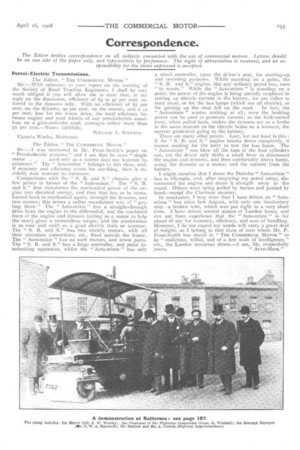Correspondence.
Page 21

If you've noticed an error in this article please click here to report it so we can fix it.
The Editor invites correspondence on all subjects connected with the use of coFnmercial motors. Letters should be on one side of the paper only, and type-written by preference. The right of abbreviation is reserved, and no responsibility for the views expressed is accepted.
Petrol-Electric Transmissions.
The Editor, " THE COMMERCIAL .MoToR."
Sir :—With reference to your report on the meeting of the Society of Road Traction Engineers, I shall be very much obliged if you will allow me to state that, in my reply on the discussion, efficiency of 8 s to 92 per cent. referred to the dynamo only. With an efficiency of 87 per cent. on the dynamo, go per cent. on the motors, and a ro per cent, loss for the worm drive, the total efficiency between engine and road wheels of our petrol-electric omnibus, on a give-and-take road, averages rather more than 70 per cent.—Yours faithfully, -WILLIAM A. STEVENS.
Victoria Works, Maidstone.
The Editor, " TEE COMMERCIAL .MOTOR."
Sir :—I was interested in Mr. Frost-Smith's paper on " Petrol-electric systems," and I see that he says " single motor . . . used only as a starter does not warrant its existence." The " Auto-mixte " belongs to this class, and, if economy and efficiency count for anything, then it decidedly does warrant its existence.
Comparisons with the " S. B. and S." chassis, give a few points in favour of the " Auto-mixte." The " S. B. and S." first transforms the mechanical power of the engine into electrical energy, and then that has to be transfort-led back to mechanical again, through the dynamo, and two motors; this seems a rather roundabout way of " getting there." The " Auto-mixte " has a straight-through drive from the engine to the differential, and the combined force of the engine and dynamo (acting as a motor to help the start) gives a tremendous torque, and the acceleration is as easy and swift as a good electric train or tramcar. The " S. B. and S." has two electric motors, with all their attendant connections, etc., fixed outside the frame. The " Auto-mixte " Las no such motors, and fewer parts. The " S. B. and S." has a large controller, and pedal interlocking apparatus, whilst the " Auto-mixte " has only a small controller, upon the driver's seat, for starting-up and reversing purposes. While standing on a point, the " S. B. and S." engine, like any ordinary petrol bus, runs " to waste." White the " Auto-mixte " is standing on a point, the power of the engine is being usefully employed in storing up electric current in the battery, for use either to start away, or for the bus lamps (which are all electric), or
for getting up the next hill on the road. In fact, the " Autcmnixte " wastes nothing at all; even the braking Power can be used to generate current, as the field-control lever, when pulled back, makes the dynamo act as a brake in the same manner as the electric brake on a tramcar, the current generated going to the battery.
There are many other points. Last, but not least is this : it the " S. B. and S." engine breaks down completely, it means sending for the lorry to tow the bus home. The " Auto-mixte " can blow all the tops of the four cylinders out, yet the driver only shifts a small lever to disconnect the engine and dynamo, and then comfortably drives home, using the dynamo as a motor, and the current from the battery.
I might mention that I drove the Daimler " Auto-mixte " bus to Olympia, and, after emptying my petrol away, disconnected the engine and drove it straight away to the stand. Others were being pulled by horses and pushed by hand—except the Clarkson steamer.
In conclusion, I may state that I have driven an " Automixte " bus since last August, with only one involuntary stop—a broken wire, which was put right in a very short time. I have driven several makes of London buses, and can say from experience thai the " Auto-mixte " is far ahead of any for economy, efficiency, and ease of handling. However, I do not expect my words will carry a great deal of weight, as I belong to that class of men whom Mr. P. Frost-Smith has stated in " THE COMMERCIAL MOTOR " to be " malicious, wilful, and of a low scale of intelligence," viz., the London motorbus driver.—I am, Sir, respectfully
yours, " AUTO-MICK."


























